
Lockheed R6V Constitution |
(Download a higher resolution picture by clicking on any
picture below.) 
 The Lockheed R6V Constitution began as a
proposal to Pan Am for an airliner with greater range and
passenger capacity than the Lockheed 049 Constellation.
Development continued during World War II under the auspices of
the Navy, which ordered two prototypes as R6Os.
The Lockheed R6V Constitution began as a
proposal to Pan Am for an airliner with greater range and
passenger capacity than the Lockheed 049 Constellation.
Development continued during World War II under the auspices of
the Navy, which ordered two prototypes as R6Os.
By the end of the war, Pan Am had decided that the Constitution and the Convair 37 were too big. The Constitution was underpowered. Engine cooling problems required that the cowl flaps had to be left partly open during cruise flight, which reduced the already inadequate range.
At the same time, Douglas gave up marketing the Globemaster I (C-74) as the DC-7. The final design for the DC-7 was considerably smaller.
The Boeing 377 Stratocruiser got the bulk of the post-war transatlantic airliner production contracts after the war. Even so, Boeing made only fifty-five 377 Stratocruisers. Convair made more 880s than Boeing made 377s.
The failure to develop the 5,500 hp Wright Typhoon turboprop was the final blow to the prospect of a giant lockheed turboprop airliner variant of the Constitution.
One novel feature of the Constitution was the main landing gear, which was composed of two struts on each side of the fuselage with two wheels mounted on each strut. Electric motors were used to spin the wheels up to landing speed before touchdown. This feature seriously impaired the pilot's ability to feel when the airplane had touched down on the runway.
The first flight of the XR6O-1 Constitution, BuNo 85163 was flown from Burbank to Muroc Army Air Base on November 9, 1946. The second XR6O-1, BuNo 85164 flew in June 1948. The two Constitutions served initially with VR-44 at NAS Alameda, California. When VR-44 was disestablished in 1950, the Constitutions were transeferred to VR-5 at NAS Moffett.
 Lockheed R6O Constitution, BuNo
85163 at Burbank, California. It was posed next to a Lockheed 12A
Electra Junior to provide a sense of its scale. Lockheed photo
via Nico Braas of the Netherlands.
Lockheed R6O Constitution, BuNo
85163 at Burbank, California. It was posed next to a Lockheed 12A
Electra Junior to provide a sense of its scale. Lockheed photo
via Nico Braas of the Netherlands.
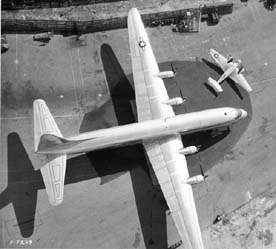 The first Lockheed R6O
Constitution, BuNo 85163 at Burbank, California. This time the
smaller airplane is a Beech C-45 . Lockheed photo via Nico Braas
of the Netherlands.
The first Lockheed R6O
Constitution, BuNo 85163 at Burbank, California. This time the
smaller airplane is a Beech C-45 . Lockheed photo via Nico Braas
of the Netherlands.
 R6O Constitution, BuNo 85163 in
flight over Rogers Dry Lake, California. Lockheed photo via Nico
Braas of the Netherlands.
R6O Constitution, BuNo 85163 in
flight over Rogers Dry Lake, California. Lockheed photo via Nico
Braas of the Netherlands.
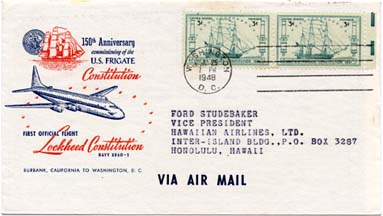 Postal cover carried by the second
Lockheed R6O Constitution on its first "official"
flight from Burbank, California to Washington, D.C. on July 25,
1948.
Postal cover carried by the second
Lockheed R6O Constitution on its first "official"
flight from Burbank, California to Washington, D.C. on July 25,
1948.
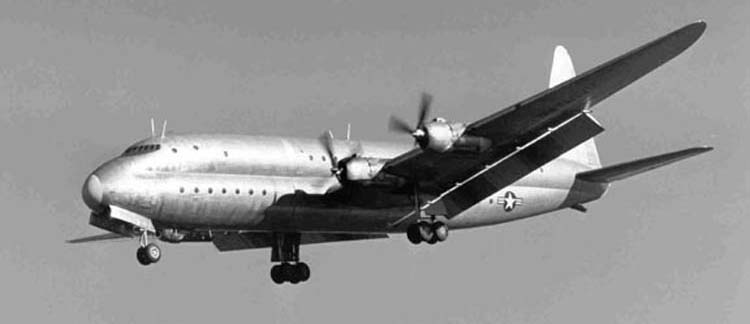 Bill Larkins, one of the founders
of the American Aviation Historical Society, took this picture of
Lockheed Constitution, BuNo 85164 on approach to land at Moffett
Naval Air Station in 1948.
Bill Larkins, one of the founders
of the American Aviation Historical Society, took this picture of
Lockheed Constitution, BuNo 85164 on approach to land at Moffett
Naval Air Station in 1948.
Check out the Northern California Chapter of the
American
Aviation Historical Society. 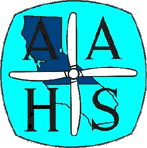
 Lockheed promotional artwork for
the R6V Constitution over Catalina Island.
Lockheed promotional artwork for
the R6V Constitution over Catalina Island.
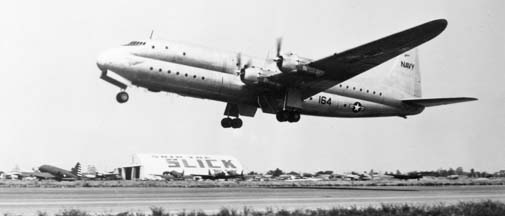 The second R6O Constitution, BuNo
85164 takes off from Burbank, California.
The second R6O Constitution, BuNo
85164 takes off from Burbank, California.
The two Constitutions were redesignated R6V in 1950. The Navy retired them in 1953.
 The first R6V Constitution, BuNo
85163 was stored at Litchfield Park, Arizona following its
retirement. It was purchased and flown to Las Vegas, but was
never put into civilian service. It was used as a billboard to
advertise Alamo Airways Fixed Base Operator and eventually scrapped.
The first R6V Constitution, BuNo
85163 was stored at Litchfield Park, Arizona following its
retirement. It was purchased and flown to Las Vegas, but was
never put into civilian service. It was used as a billboard to
advertise Alamo Airways Fixed Base Operator and eventually scrapped.
The second Constitution, BuNo 85164 was flown to Opa Locka, Florida. It was disassembled, moved off the airport and was reassembled on Northwest 135th Street not far from the field. It was scrapped in 1978. Some of its propeller blades have been preserved by the family of its last owner.
Giant Airplanes of the 1940s |
||||||
| First Flight | Wing Span | Length | Wing Area | Gross Weight | Engines | |
| Bristol Brabazon | 1949 |
230ft,00in |
177ft,00in |
5,317 |
290,000 |
8 x 2,650hp Bristol Centaurus |
| Hughes Flying Boat (Spruce Goose) | 1947 |
320ft,00in |
218ft,06in |
11,430 |
300,000 |
8 x 3,500hp R4360 |
| Convair XC-99 | 1947 |
230ft,00in |
185ft,00in |
4,772 |
320,000 |
6 x 3,500hp R4360 |
| Northrop YB-49 Flying Wing | 1947 |
172ft,00in |
53ft,01in |
4,000 |
194,000 |
8 x 3,700 lb J-35 |
| Convair B-36 | 1946 |
230ft,00in |
162ft,01in |
4,772 |
370,000 |
6 x 3,500hp R4360, 4 x 5,200 lb J-47 |
| Lockheed R6V Constitution | 1946 |
189ft,01in |
156ft,01in |
3,610 |
184,000 |
4 x 3,000hp R4360 |
| Douglas DC-6 | 1946 |
117ft,06in |
100ft,07in |
1,463 |
97,200 |
4 x 2,100 hp R2800 |
| Douglas C-74 Globemaster | 1945 |
173ft,03in |
124ft,02in |
2,506 |
145,000 |
4 x 3,000hp R4360 |
| Blohm und Voss BV-238 | 1945 |
197ft,05in |
142ft,8in |
3,930 |
176,400 |
6 x BMW 801 |
| Boeing C-97 Stratofreighter/Stratotanker | 1945 |
141ft,03in |
110ft,04in |
1,738 |
120,000 |
4 x 3,000hp R4360 |
| Lockheed 049 Constellation | 1943 |
123ft,00in |
95ft,02in |
1,650 |
86,200 |
4 x 2,000 hp R3350 |
| Martin JRM Mars | 1942 |
200ft,00in |
117ft,00in |
3,683 |
144,000 |
4 x 2,000 hp R3350 |
| Douglas DC-4 | 1942 |
117ft,06in |
93ft,10in |
1,460 |
73,000 |
4 x 1,350 hp R2000 |
| Douglas XB-19 | 1941 |
212ft,00in |
132ft,00in |
4,492 |
164,000 |
4 x 2,000 hp R3350 |
| Tupolev Ant-20bis | 1940 |
206ft,08in |
111ft,11in |
5,231 |
99,200 |
6 x 1,200 hp M-34FRNV |
| Blohm und Voss BV-222 | 1940 |
150ft,11in |
120ft |
2,744 |
108,000 |
6 x 1,000 hp BMW-Bramo Fafnir 323R |
Send a message to Brian.